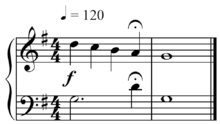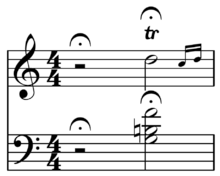Fermata



A fermata [ferˈmaːta] (also known as a hold, pause, colloquially a birdseye ' when placed on a note or a rest) is a symbol of musical notation indicating that the note should be prolonged beyond its normal duration or note value would indicate.[2] Exactly how much longer it is held is up to the discretion of the performer or conductor, but twice as long is common. It is usually printed above but can be occasionally below (when it is upside down) the note to be extended.
When a fermata is placed over a bar or double-bar, it is used to indicate the end of a phrase or section of a work. In a concerto, it indicates the point at which the soloist is to play a cadenza.[3]
A fermata can occur at the end of a piece (or movement) or in the middle of a piece. It can be followed by either a brief rest or more notes.[4]
Other names for a fermata are corona (Italian), point d'orgue (French), Fermate (German), and calderón (Spanish).[2]
History and use
This symbol appears as early as the 15th century. It is quite common in the works of Guillaume Dufay and Josquin des Prez.
In chorales by Johann Sebastian Bach and other composers of the Baroque, the fermata often signifies only the end of a phrase, and a breath is to be taken. In a few organ compositions, the fermatas occur in different measures for the right and left hands and for the feet, which would make holding them impractical.
The word lunga (shortened form of the Italian lunga pausa, meaning "long pause") is sometimes added above a fermata to indicate a longer duration, the length of which is at the discretion of the performer rather than note values.[5]
Some modern composers (including Francis Poulenc, Krzysztof Penderecki, and Luigi Nono) have expanded the symbol's usage to indicate approximate duration, incorporating fermatas of different sizes, square- and triangle-shaped fermatas, and so on to indicate holds of different lengths. However, that is not standard usage.
See also
Footnotes
- ↑ Sir George Grove (1904). Grove's Dictionary of Music and Musicians, Vol. 1, p.442. John Alexander Fuller-Maitland, ed. Macmillan Company.
- 1 2 The Harvard Dictionary of Music, p. 310
- ↑ The Oxford Dictionary of Music, p. 293
- ↑ McElheran, Conducting Technique, Chapter XVII, "Fermatas", p. 85. The author classifies them into three types: fermatas followed by uninterrrupted sound, ffermatas followed "by a short period of silence," and fermatas "followed by a long period of silence." After that classification, the author gives detailed advice for conducting each type.
- ↑ David Fallows. "Lunga". In L. Root, Deane. Grove Music Online. Oxford Music Online. Oxford University Press. (subscription required)
References
- Kennedy, Michael (1994). The Oxford Dictionary of Music (Second ed.). Oxford: Oxford University Press. ISBN 0-19-869162-9.
- McElheran, Brock (1989). Conducting Technique. Oxford: Oxford University Press.
- Randel, Don Michael, ed. (2003). The Harvard Dictionary of Music (Fourth ed.). Cambridge, Massachusetts: Belknap Press of Harvard University Press. ISBN 0-674-01163-5.
| Look up fermata in Wiktionary, the free dictionary. |